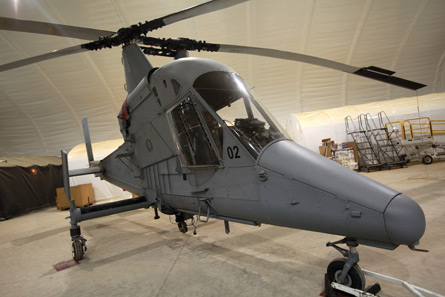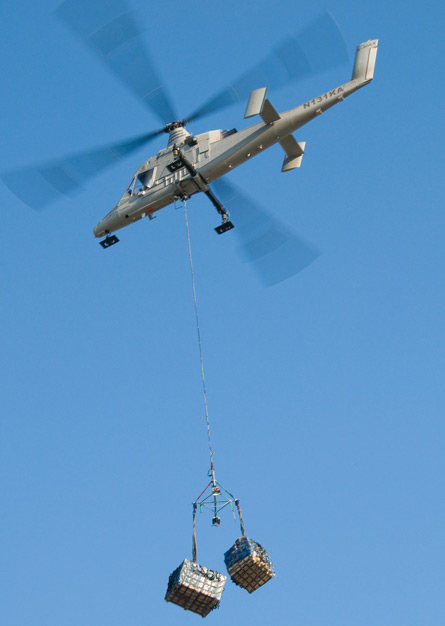Perhaps because purpose-built unmanned air vehicles have become a fact of life in the skies over Afghanistan, the introduction last December of a full-size helicopter, converted into an "optionally piloted" airborne delivery truck, generated little attention. Yet the unmanned Kaman Aerospace K-MAX represents, arguably, not only a greater technical achievement but a bigger step towards a future where commercial aircraft with empty cockpits ply their trade.
Expensive piloting skills are no longer required within Marine Unmanned Aerial Vehicle Squadron 1. Whenever one of the two K-MAX currently attached to its Cargo Resupply component is tasked, an NCO (not pilot-qualified) climbs in and starts it up. He then switches control to another NCO at the nearby main operating base, climbs out and walks away. NCO No 2 presses a button to send the helicopter off on its flight plan. At its destination, a grunt in a foxhole guides it to the landing zone with a games console. When it lands back at base, another operator gets back in and shuts it down.
 |
|---|
Kaman Aerospace |
K-MAX has completed its first six-month trial in Helmand and has already been extended to the end of the fiscal year (in September); the contract allows for one further extension. Since its arrival in December 2011, it has flown over 400 missions and transported 1.3 million pounds of kit, both to and from USMC combat outposts. Payloads range from a single 4,200lb sling load to 28,800lb lifted in a single day. During March alone it ferried over half a million pounds of cargo. It can lift up to 6,000lb of cargo at sea level, or 4,000lb at 15,000ft density altitude.
AUTOPILOT FUNCTION
The helicopter flies five or six missions on the trot, invariably by night and at altitude, guided either by its autopilot along GPS waypoints, or by a ground controller. "Handling" of the flight controls remains an autopilot function throughout.
With the flightplan uploaded it can take off and depart autonomously from the main operating base. As it approaches the forward operating base (FOB), marines will put "eyes on the aircraft" using NVG, initiate a positive handover from the main operating base and use a hand controller - familiar to video gamers - to input simple left-right, up-down commands to position loads over the selected landing zone - or anywhere else they want it.
K-MAX features a four-hook cargo carousel that allows it to deposit loads at multiple locations during a single round-trip. The platform can be re-tasked at any stage. The outbound loads typically contain food, water and ammunition but there is the opportunity for two-way traffic, for example if the patrol needs to return equipment for repair.
During earlier trials in Arizona, the helicopter dropped 10 GPS-guided JPADS (parachute-steered payloads), two of which were released remotely from the ground control station. Four parachutes with containers, each weighing 1,100lb, were airdropped at two- to three-second intervals, from 2,000ft AGL at 60kt airspeed.
FAST, RELIABLE
Maj Kyle O'Connor, detachment officer for MUAVS# 1 who is overseeing the deployment, says that the Marine Corps had been looking for ways to get trucks off the road for some time. "We wanted a fast, reliable platform to resupply our combat outposts without putting Marines in more danger of IEDs."
 |
|---|
Kaman Aerospace |
Serviceability has been high, with the helicopter requiring less than one maintenance man-hour per flight hour. "It's such a new system that there isn't a lot of reliability data," says O'Connor. "The latest extension will give us more time to gather performance data from [within] the operational environment."
The K-MAX first came to the notice of the USMC in 1998, when Kaman demonstrated its BURRO (broad area unmanned responsive re-supply operation) concept in the Arizona desert. The idea was to resupply Marines beyond the line-of-advance during a beach assault, without putting lives at risk. It is a tactic currently little in demand. These trials never dispensed with the pilot altogether, but there was talk of a single, manned K-MAX supervising a gaggle of load-carrying UAVs.
AFGHAN CAMPAIGN
In March 2007, to make it more attractive to the requirements of the Afghan campaign, it formed a strategic partnership with Lockheed Martin, with the latter taking the prime contractor role. The corporation integrated a mission-management computer, datalinks (for line-of-sight and beyond-line-of-sight communications) and developed the ground control stations. The first critical demonstration of the team's handiwork was made to the Corps' war-fighting laboratory in January 2010, at the Dugway proving grounds in Utah.
The helicopter remained "populated" - airspace and safety regulations prohibit unmanned flights on US soil. The individual was finally dispensed with after a short period of in-country trials in December.
 |
|---|
Kaman Aerospace The K-MAX can lift up to 6,000lb of cargo at sea level |
Kaman has ploughed a solitary furrow towards the goal of unmanned helicopters since 1957 (search for "You asked for it" on YouTube to see how simple they made it look. Even the TV presenter got the hang of it). During tests at White Sands during the 1970s, a pilotless UH-1 served as a testbed for roles such as artillery spotting and comms relay, and surveillance using a video camera and, later, an EO/IR turret. As for the autopilot, the absence of a tail rotor made the integration of dual-redundant actuators on each flight-control linkage less problematic that it might otherwise have been.
Marines serving with the Cargo Resupply Detachment of MUAVS# 1 have helped create new procedures for the aircraft, for safety, landing zone and airspace coordination. One controller says he has been surprised and impressed by the aircraft's performance: "The precision of the system is amazing."
Notwithstanding the relative skill-sets involved, Kaman UAS product group general manager Terry Fogerty has noted how, once an NCO operator takes charge of the K-MAX for the first time, the mood alters in a familiar way: "They are accustomed to having a 'back-up' riding in the helicopter during training. Once he walks away from the aircraft, they no longer have that safety net. It's like a student pilot during his first solo flight - with no instructor alongside. It's an interesting dynamic: even though you are trained and ready for the next step, there is still some trepidation."
GREATER DEMAND
As NATO forces prepare to withdraw from Afghanistan, the K-MAX will be working alongside them. "As the drawdown occurs, there will be fewer vehicles and thus a greater demand for air transportation," says Maj O'Connor. "With K-MAX extended, we hope to use it to assist in retrograde operations."
Whether or not USMC commanders keep the rotorcraft as a permanent addition to its unmanned aerial assets, the technology has been proven in a highly demanding environment. In theory at least, the "optionally piloted" concept can be applied to any number of aircraft types. Boeing has demonstrated its MD530F Little Bird (which first flew in 2004) supporting roles such as resupply, reconnaissance and surveillance. Last November it also landed on a moving trailer, to illustrate a potential maritime capability.
Terry Fogerty says 55 years since it first took flight in Arizona, the idea's time has finally come. "Overcoming public resistance will be our greatest challenge. But even if we have a way to go before passengers will accept a pilot-free service, in 15-20 years I can see a Fedex Boeing 747 flying without one. It's only a matter of time."
Source: Flight International



















